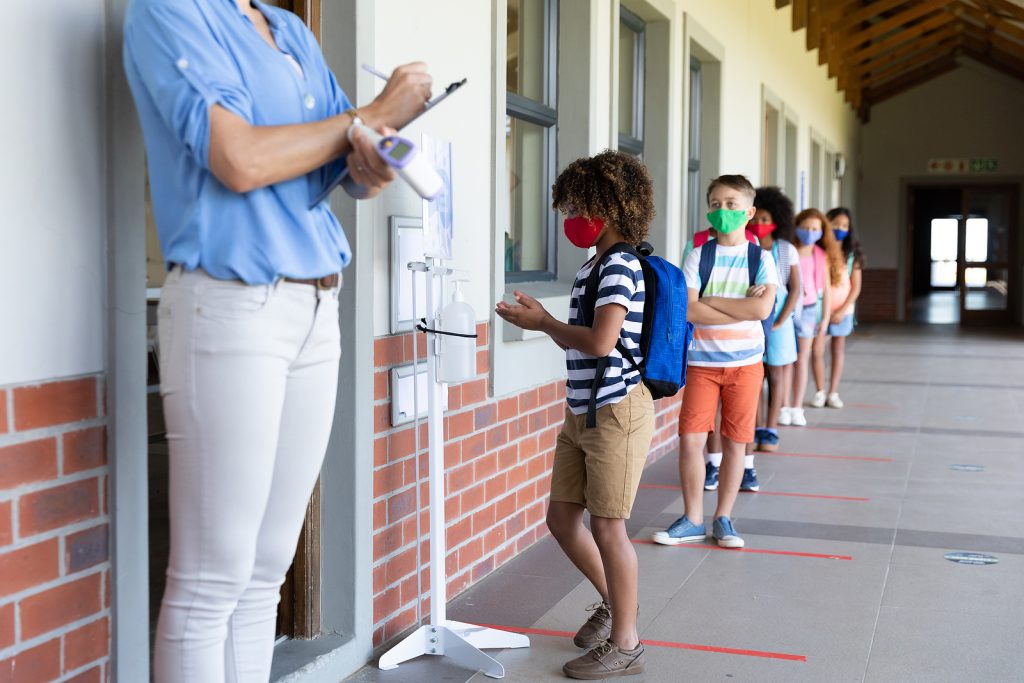As the 2020-2021 school year comes to a close, there is more focus than ever on reopening our schools safely. It’s been a long year of online learning, Zoom classes, of juggling the needs of our students with the safety of our teachers, and for many, it’s been one year too long. But it looks as if the age of Zoom may be winding down, at least in California.
The LA Times reports that in California, nearly 90% of public school districts are returning to in-person or hybrid instruction, and that 53% of elementary students, but only 43% of secondary school students have returned to school.
As California reopens its schools, it’s time to take a look at how school districts can utilize the new influx of state and federal funding to not only provide safe learning environments, but a sustainable haven for students and teachers alike.
Breathing Easy
It is vitally important to reopen schools safely, and a large part of that is centered on adequate ventilation. In their guidance on reopening, the CDC and California Department of Public Health recommend increasing ventilation to prevent the spread of COVID-19, including opening windows (when it is safe to do so), as well as updating school HVAC systems to include filters with a minimum efficiency reporting value (MERV) of at least 13.
Improving indoor air quality can not only help in the fight against COVID-19, but also improve the overall health of students and faculty. As an example, USA students lose almost 14 million school days due to asthma, and teachers report one of the highest rates of work-related asthma, while the Environmental Protection Agency (EPA) estimates that around 46% of schools have environmental conditions that contribute to poor indoor air quality, including allergens from cockroaches, dust mites, rodents, and fungi. That’s not including the cocktail of chemicals, volatile organic compounds, and other respiratory irritants found in the same study.
In addition, low-quality indoor air not only increases the number of asthma triggers, but studies have also found correlations between lower ventilation rates and increased absences due to respiratory infections.
Improved indoor air quality has obvious impacts on student performance – less sick days means more in-class time – but also less obvious ones. One Finnish study found that in schools unable to meet the recommended ventilation rate, students were more likely to perform poorly on math tests.
Providing enhanced indoor air quality through updated HVAC systems is not only improving student and teacher health and performance, it can be a sustainable choice, too.
A well-installed HVAC system can lower energy and water consumption, as well as providing years of use. They can be run on 100% outdoor air to flush out contaminants, or even run on geothermal power.
Show me the money
California schools have a wealth of funding options for creating sustainable facilities, especially now that the pressure is on to enhance existing facilities in the push to reopen.

In an interview with Green Technology Magazine, Lisa Silverman, Executive Officer of the Office of Public School Construction said, “Sustainable schools are an important consideration for all school districts as they work to return to on-campus, in-person learning. Federal and State funding supporting school districts to ready campuses for returning students is coming. Incorporating sustainable features could add some or no additional costs to school districts already designing and updating their campuses.”
And, more specifically: “Ventilation system projects are an eligible expenditure in both School Facility Program New Construction and Modernization Projects that are administered by the State Allocation Board. For projects already submitted and/or approved by our office, the Division of the State Architect, and the State Allocation Board, school districts can consider pursuing change orders as part of existing construction contracts. We encourage districts to reach out to our office if they wish to discuss this option further.”
In addition to state resources, the American Rescue Plan will include $130 billion for K-12 schools. While part of this funding is reserved for combating “learning loss”, the rest may be used for implementing facilities upgrades to accelerate the safe reopening of schools. (Source) Considering the CDC and CDPH’s reopening plans include specific guidance on improving ventilation (and the health benefits possible), this money could be a big boost in updating our ancient HVAC, and providing higher indoor air quality.
In short, utilizing the money from the American Rescue plan and state funding sources for facilities improvements that increase campus sustainability is a no-brainer.
A different kind of classroom
Of course, all of this is moot if students don’t actually return to school. In an essay by educator Andrew Simmons, he describes the return to in-person learning in his Bay Area district: “I’m lucky. My Bay Area district spent money so my classroom would be safe and conducive to learning when hybrid instruction began in mid-March. Yet, every period, fewer students join me in that room. I put on a KN95 and fling open the door and a kid or two leans against lockers in the hallway.” He goes on to describe ways to entice students to return – through hikes, outdoor games (within the same cohorts), or competitions. In short, activities that are fun, full of fresh air, and heavy on socializing while social distancing.
Maybe the solution to both adequate ventilation and student retention lies in another sustainable alternative: re-imagining outdoor spaces as classrooms.

In an interview, Tony Thurmond, California State Superintendent of Public Instruction says, “Under normal circumstances, sustainability is very important. During the COVID-19 pandemic sustainability has taken on an even greater need. For example, when you think about ventilation. Just having access to outdoor air helps to mitigate the spread of COVID, and we want to help California schools to promote healthier, more sustainable learning environments. I think California is already leading in this area with some of our schools and campuses.”
“My office is sharing information on outdoor learning. I remember, years ago, advocates talking about schools without walls, and back then what they were saying is that we can educate our students better by taking learning to the environment. If you want to teach science, what better place to teach science than at a beach or at the preserve, you know, or some way that gets students in the outdoors?”
“It [outdoor learning] also promotes hands-on learning, which we know is one of the best forms of learning for our students. And so now that we find ourselves in the COVID-19 era, outdoor learning presents an even more important opportunity for us to mitigate the spread of COVID-19.”
Research has shown that outdoor learning promotes better behavior, increased achievement, and overall better performance for students. It may just be one of the best solutions, especially when California schools are battling learning loss, outdated ventilation systems, and student attrition.
For more tips on how to integrate sustainable architecture into your school’s facilities, check out: (Back to Campus Facilities Toolkit).
Interview responses have been edited for length and clarity.

